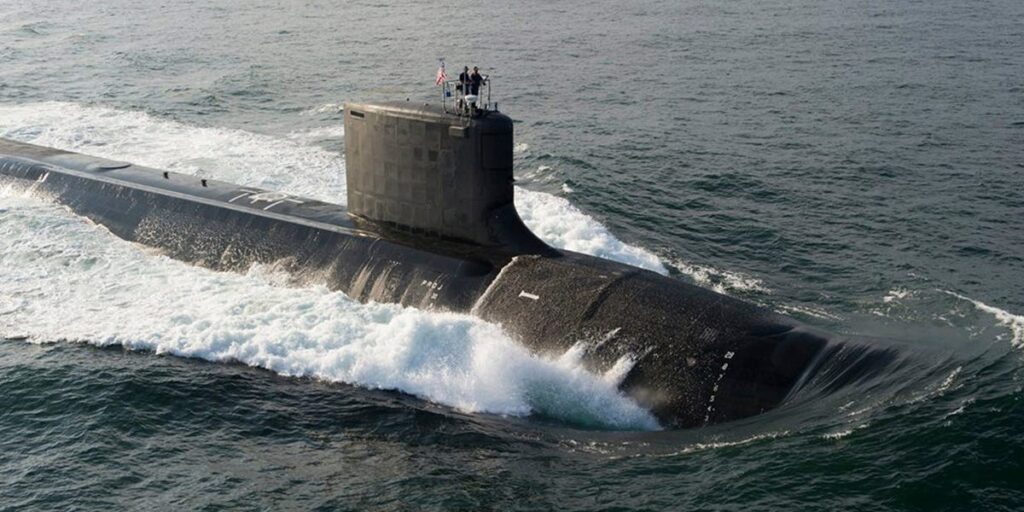- Pentagon leadership plans to pull 8%, or $50 billion, from various projects to fund Trump’s priorities.
- Exempt programs include nuclear modernization, missile defense, and Virginia-class submarines.
- The memo has triggered confusion about its implications for the Navy’s crucial shipbuilding effort.
A $50 billion funding shift ordered by President Donald Trump’s new defense secretary makes attack submarines a priority but raises questions for the rest of the Navy.
Secretary of Defense Pete Hegseth intends to pull roughly 8% of the Biden administration’s fiscal year 2026 budget from existing programs and shift them to Trump’s recently designated priorities. The plan has led to confusion about what this could mean for a critical area needed to confront China: Navy shipbuilding.
Only 17 Pentagon program areas would be exempted, per a memo by Hegseth, including “Southwest Border Activities,” Virginia-class attack submarines, and “executable” surface ships.
Building Navy warships takes years and requires consistent funding to private shipbuilders who employ the skilled technicians and industrial processes needed to build advanced warships. The directive leaves it unclear if the new administration wants to continue building aircraft carriers, ballistic missile submarines, frigates, amphibious assault ships, and other vessels.
“The Secretary of Defense is injecting a colossal amount of confusion and churn and uncertainty into the budgeting process,” Bryan McGrath, a defense and national security consultant and retired Navy commander, told Business Insider in an interview on Thursday.
Details of the plans were reported this week, and Hegseth said publicly that the budget shifts are “refocusing” on “top line stuff” and eliminating “woke” projects.
For Navy shipbuilding — a roughly $40 billion industrial effort every year — Virginia-class attack subs are the only bright spot. But Virginia-class submarines are facing yearslong construction delays along with many other warship classes that are essential to building a larger and more modern fleet.
Attack subs and budget questions
Virginia-class submarines were the only Navy vessels specifically identified as a priority in the memo.
The Virginia-class attack subs Trump’s Pentagon is shielding have long been seen as a critical capability for countering China, a US rival with a substantial surface fleet and long-range missiles that can threaten US ships.
US submarines are difficult to track and are less threatened by Chinese ballistic missiles, Tom Shugart, an adjunct senior fellow at the Center for a New American Security and retired Navy submarine officer, said in a call with BI on Thursday.
The memo did not mention plans for the new Columbia-class subs, an important part of the already underway nuclear modernization process.
The ballistic missile subs, known as SSBNs or “boomers,” will carry Trident II missiles armed with nuclear warheads. These subs are harder to target and destroy compared to silo-based intercontinental ballistic missiles or bombers, helping to preserve US second-strike capabilities.
The Columbia-class submarines are likely to be included within the “nuclear modernization” category, Shugart said, as they are perhaps the most important part of nuclear modernization.
For surface vessels, only ships identified as “executable surface ships” are free from budget cuts — raising questions about what “executable” means. Multiple Navy shipbuilding programs are plagued by production delays, such as new Constellation-class frigates and the Ford-class aircraft carriers Trump recently called out in a discussion of waste and fraud. Uncertain budgets are a factor that has driven ship delays and rising costs.
Shipbuilding is measured in years. Shipyard workers began construction on the second Ford-class carrier in 2015. It’s finally slated to join the fleet later this year.
Shugart and McGrath expressed confusion about what could qualify as an “executable surface ship.” The term could include ships like the Arleigh Burke-class destroyers, which shipyards are actively manufacturing with firm designs and timelines.
It likely “means surface ships that are buildable with the industrial base as we have it today,” said Shugart. Warships like the new class of frigate that aren’t on hot production lines could be in trouble.
It does not say “surface combatants;” it says “surface ships,” Shugart noted. “I’m not sure what that means with respect to aircraft carriers,” he said. “It may also apply to surface auxiliaries, like oilers and tankers.”
The Navy declined to comment on the priorities memo released by the Office of the Secretary of Defense, which didn’t respond to BI’s request on Friday for clarity on what an “executable” ship means or the confusion the memo has caused.
Dramatic financial “refocusing” risks difficult battles with Congress, suggesting the money may come from elsewhere.
McGrath said that the Pentagon leadership’s planned reallocations appear poised to reduce readiness in more mundane yet critical areas of military funding, including money for spare parts, equipment maintenance, and servicemember quality of life; the Navy spends $14.5 billion annually to maintain its ships.
That approach could include things like barracks renovations, improved food, and the availability of decent childcare for parents in uniform, all factors that can affect troop morale and retention rates. Readiness woes could be exacerbated by cuts to the Navy’s workforce of civilian experts who repair ships.
“That money is almost certainly going to be offered up for some portion of it,” said McGrath. “Because when you take core readiness, shipbuilding, submarines and weapons, munitions, and you say ‘You can’t cut from those things,’ there’s just not a lot of fat there to go after.”
Proposed budget moves are likely to be reviewed by the secretary of defense’s office first, McGrath noted, and in some cases may be reallocated back to where they came from in the first place, making cut identification a crushing drill for the hard-working staff officers in the Pentagon.
Generally speaking, “it’s a terrible way to run a railroad,” he said.
Read the full article here
















